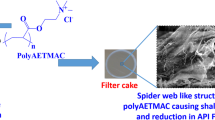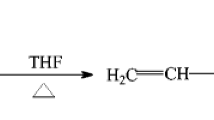Abstract
An anionic polymer P (ANAN) of acrylamide, N-vinyl-2-pyrrolidone and 2-acrylamide-2-methylpropanesulfonic acid was synthesized through free radical polymerization and initiated by 2,2′-Azobis (2-methylpropionamide) dihydrochloride as an anti-high temperature and anti-calcium and magnesium contamination fluid loss control additive for water-based drilling fluid. The P (ANAN) was characterized by 13C-NMR and 1H-NMR, FTIR, elemental analysis and GPC analysis. The fluid loss tests were carried on different WBDFs. The results showed that this polymer can resist 4.5 × 105 ppm of Cl−1, 4 × 105 ppm of Ca2+ contamination at low pH environment caused by acid gas invasion in drilling fluid at 180 °C. The fluid loss control mechanisms of P (ANAN) were investigated by Zeta potential analysis, particle size distribution analysis and mud cake quality analysis. The thermal stability was investigated by TGA analysis. The results illustrate that the P (ANAN) exhibits a stronger interaction with clays and higher-temperature resistance, and it can improve the colloidal dispersion property obviously for drilling fluid under salts, calcium and magnesium contamination and even under circumstances of acid gas invasion conditions. Due to its superior fluid loss control properties, the P (ANAN) can be a promising polymer for water-based drilling fluid in deep and ultra-deep well drilling applications.












Similar content being viewed by others
References
Mao H, Qiu Z, Shen Z, Huang W (2015) Hydrophobic associated polymer based silica nanoparticles composite with core-shell structure as a filtrate reducer for drilling fluid at utra-high temperature. J Pet Sci Eng 129:1–14. https://doi.org/10.1016/j.petrol.2015.03.003
Chu Q, Lin L (2019) Effect of molecular flexibility on the rheological and filtration properties of synthetic polymers used as fluid loss additives in water-based drilling fluid. RSC Adv 9:8608–8619. https://doi.org/10.1039/c9ra00038k
Liu F, Jiang G, Peng S et al (2016) Amphoteric polymer as an anti-calcium contamination fluid-loss additive in water-based drilling fluids. Energy Fuels 30:7221–7228. https://doi.org/10.1021/acs.energyfuels.6b01567
Orldans U, Facult UFR, Chartres D et al (1998) Structural organization of Na–and K–montmorillonite suspensions in response to osmotic and thermal stresses. Clays Clay Miner 46:636–648
Murray HH (2000) Traditional and new applications for kaolin, smectite, and palygorskite: A general overview. Appl Clay Sci 17:207–221. https://doi.org/10.1016/S0169-1317(00)00016-8
Yin D, Peng S, Liu G (2014) Innovative non-aqueous fluids technology improves drilling efficiency significantly in dealing with divalent complex salt formation under hthp conditions. In: International petroleum technology conference. International petroleum technology conference
Cao J, Meng L, Yang Y et al (2017) Novel Acrylamide/2-Acrylamide-2-methylpropanesulfonic Acid/4-Vinylpyridine terpolymer as an anti-calcium contamination fluid-loss additive for water-based drilling fluids. Energy Fuels 31:11963–11970. https://doi.org/10.1021/acs.energyfuels.7b02354
Hall SB, Duffield JR, Williams DR (1991) A reassessment of the applicability of the DLVO theory as an explanation for the Schulze–Hardy rule for colloid aggregation. J Colloid Interface Sci 143:411–415. https://doi.org/10.1016/0021-9797(91)90274-C
Nowicki W, Nowicka G (1994) Verification of the Schulze–Hardy rule: a colloid chemistry experiment. J Chem Educ 71:624. https://doi.org/10.1021/ed071p624
Plank JP, Hamberger JV (2007) Field experience with a novel calcium-tolerant fluid-loss additive for drilling muds. Soc Pet Eng. https://doi.org/10.2118/18372-ms
Liang LS, Ibrahim MNM (2013) Preparation of lignin graft copolymer as a fluid loss additive for water-based mud. Eng Sci 9:39–49
Salami OT, Plank J (2013) Preparation and properties of a dispersing fluid loss additive based on humic acid graft copolymer suitable for cementing high temperature (200°C) oil wells. J Appl Polym Sci 129:2544–2553. https://doi.org/10.1002/app.38980
Wu YM, Zhang BQ, Wu T, Zhang CG (2001) Properties of the forpolymer of N-vinylpyrrolidone with itaconic acid, acrylamide and 2-acrylamido-2-methyl-1-propane sulfonic acid as a fluid-loss reducer for drilling fluid at high temperatures. Colloid Polym Sci 279:836–842. https://doi.org/10.1007/s003960100494
Tiemeyer C, Plank J (2012) Working mechanism of a high temperature (200°C)synthetic cement retarder and its interaction with an amps-based fluid loss polymer in oil well cement. J Appl Polym Sci 124:4772–4781. https://doi.org/10.1002/app
Asiri AM (2011) Improved photochromic and fatigue performance furylethylidene-succinicanhydride doped in polyurethane thin film. Polym Eng Sci. https://doi.org/10.1002/pen
Dias FTG, Souza RR, Lucas EF (2015) Influence of modified starches composition on their performance as fluid loss additives in invert-emulsion drilling fluids. Fuel 140:711–716. https://doi.org/10.1016/j.fuel.2014.09.074
Warren B, van der Horst P, Stewart W (2003) Application of amphoteric cellulose ethers in drilling fluids. In: International symposium on oilfield chemistry. Society of Petroleum Engineers, pp 1–11. https://doi.org/10.2118/80210-MS
Menezes RR, Marques LN, Campos LA et al (2010) Use of statistical design to study the influence of CMC on the rheological properties of bentonite dispersions for water-based drilling fluids. Appl Clay Sci 49:13–20. https://doi.org/10.1016/j.clay.2010.03.013
Son AJ, Ballard TM, Loftin RE (2007) temperature-stable polymeric fluid-loss reducer tolerant to high electrolyte contamination. SPE Drill Eng 2:209–217. https://doi.org/10.2118/13160-pa
Ujma KHW, Plank JP (2007) A new calcium-tolerant polymer helps to improve drilling-mud performance and to reduce costs. SPE Drill Eng 4:41–46. https://doi.org/10.2118/16685-pa
Bai X, Yang Y, Xiao D et al (2015) Synthesis, characterization, and performance evaluation of the AM/AMPS/DMDAAC/SSS quadripolymer as a fluid loss additive for water-based drilling fluid. J Appl Polym Sci 132:1–9. https://doi.org/10.1002/app.41762
Perricone AC, Enright DP, Lucas JM (2007) Vinyl sulfonate copolymers for high-temperature filtration control of water-based muds. SPE Drill Eng 1:358–364. https://doi.org/10.2118/13455-pa
Xie B, Qiu Z, Huang W et al (2013) Characterization and aqueous solution behavior of novel thermo-associating polymers. J Macromol Sci Part A Pure Appl Chem 50:230–237. https://doi.org/10.1080/10601325.2013.742818
An Y, Jiang G, Qi Y et al (2015) Synthesis of nano-plugging agent based on AM/AMPS/NVP terpolymer. J Pet Sci Eng 135:505–514. https://doi.org/10.1016/j.petrol.2015.10.014
Chu Q, Luo P, Zhao Q et al (2013) Application of a new family of organosilicon quadripolymer as a fluid loss additive for drilling fluid at high temperature. J Appl Polym Sci 128:28–40. https://doi.org/10.1002/app.38096
Levitt D, Klimenko A, Jouenne S et al (2013) Overcoming design challenges of chemical EOR in high-temperature, high salinity carbonates. In: SPE middle East oil and gas show and conference. Society of Petroleum Engineers, pp 1–15. https://doi.org/10.2118/164241-MS
Zhu D, Hou J, Chen Y et al (2018) In Situ surface decorated polymer microsphere technology for enhanced oil recovery in high-temperature petroleum reservoirs. Energy Fuels 32:3312–3321. https://doi.org/10.1021/acs.energyfuels.8b00001
Tessarolli F, Souza S, Gomes A, Mansur C (2019) Gelation kinetics of hydrogels based on Acrylamide–AMPS–NVP terpolymer, bentonite, and polyethylenimine for conformance control of oil reservoirs. Gels 5:7. https://doi.org/10.3390/gels5010007
Zhong H, Qiu Z, Sun D et al (2015) Inhibitive properties comparison of different polyetheramines in water-based drilling fluid. J Nat Gas Sci Eng 26:99–107. https://doi.org/10.1016/j.jngse.2015.05.029
Khodja M, Canselier JP, Bergaya F et al (2010) Shale problems and water-based drilling fluid optimisation in the Hassi Messaoud Algerian oil field. Appl Clay Sci 49:383–393. https://doi.org/10.1016/j.clay.2010.06.008
Saadati K, Kabiri K, Marandi GB (2014) Synthesis and characterization of phosphonic-acrylic organogels. Int J Polym Mater Polym Biomater 63:430–437. https://doi.org/10.1080/00914037.2013.854212
Ajithkumar MP, Yashoda MP, Prasannakumar S (2014) Synthesis, characterization, microstructure determination and thermal studies of poly(N-vinyl-2-pyrrolidone-maleic anhydride-styrene) terpolymer. Iran Polym J 23:93–101. https://doi.org/10.1007/s13726-013-0204-9
Zhong H, Qiu Z, Huang W, Cao J (2012) Poly (oxypropylene)-amidoamine modified bentonite as potential shale inhibitor in water-based drilling fluids. Appl Clay Sci 67–68:36–43. https://doi.org/10.1016/j.clay.2012.06.002
Miranda-Trevino JC, Coles CA (2003) Kaolinite properties, structure and influence of metal retention on pH. Appl Clay Sci 23:133–139. https://doi.org/10.1016/S0169-1317(03)00095-4
Kolay PK, Ramesh KC (2016) Reduction of expansive index, swelling and compression behavior of kaolinite and bentonite clay with sand and class c fly ash. Geotech Geol Eng 34:87–101. https://doi.org/10.1007/s10706-015-9930-4
Mao H, Qiu Z, Xie B, et al (2016) development and application of ultra-high temperature drilling fluids in offshore oilfield around Bohai Sea bay basin, China. In: Offshore Technology conference asia. Offshore technology conference
Zadaka D, Radian A, Mishael YG (2010) Applying zeta potential measurements to characterize the adsorption on montmorillonite of organic cations as monomers, micelles, or polymers. J Colloid Interface Sci 352:171–177. https://doi.org/10.1016/j.jcis.2010.08.010
Tien C, Bai R, Ramarao BV (1997) Analysis of cake growth in cake filtration: effect of fine particle retention. AIChE J 43:33–44. https://doi.org/10.1002/aic.690430106
Yao R, Jiang G, Li W et al (2014) Effect of water-based drilling fluid components on filter cake structure. Powder Technol 262:51–61. https://doi.org/10.1016/j.powtec.2014.04.060
Arthur KG, Peden JM (1988) The evaluation of drilling fluid filter cake properties and their influence on fluid loss. In: International meeting on petroleum engineering. Society of Petroleum Engineers, pp 705–717. https://doi.org/10.2118/17617-MS
Acknowledgments
This work is supported by the Open Fund (PLC20180704) of the State Key Laboratory of Oil and Gas Reservoir Geology and Exploitation (Chengdu University of Technology).
Author information
Authors and Affiliations
Corresponding author
Ethics declarations
Conflict of interest
The authors declared that they have no conflicts of interest to this work. We declare that we do not have any commercial or associative interest that represents a conflict of interest in connection with the work submitted.
Additional information
Publisher's Note
Springer Nature remains neutral with regard to jurisdictional claims in published maps and institutional affiliations.
Rights and permissions
About this article
Cite this article
Mao, H., Wang, W., Ma, Y. et al. Synthesis, characterization and properties of an anionic polymer for water-based drilling fluid as an anti-high temperature and anti-salt contamination fluid loss control additive. Polym. Bull. 78, 2483–2503 (2021). https://doi.org/10.1007/s00289-020-03227-y
Received:
Revised:
Accepted:
Published:
Issue Date:
DOI: https://doi.org/10.1007/s00289-020-03227-y




